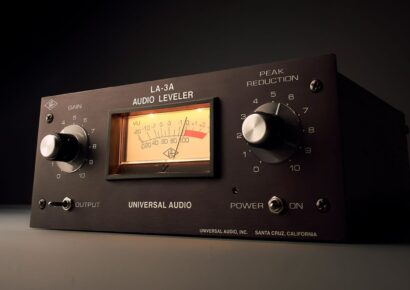Dissecting the gear of Muse's spaceman.
In today’s fragile musical ecology it’s rare to see bands maintain the longevity and legacy as Muse. For two decades, the Grammy award-winning British trio, with Matt Bellamy as frontman, have created a steady vein of Orwellian riff-heavy rockers such as ‘Knights of Cydonia’ and ‘Time Is Running Out,’ garnering incredible commercial success along the way.
Read up on all the latest features and columns here.
However, Muse simply wouldn’t be the band they are without being led by the idiosyncratic persona of their frontman, whose insane musical chops and unfathomable vocal range have defined Muse’s brand of symphonic space rock and written him into history as one of the best guitarists of the 21st century.
We dive into Bellamy’s insane collection of guitars, amps and effects to pinpoint his infamously interstellar guitar tones over the years.
Guitars
Manson DL-1 ‘Delorean’
After the initial success of Muse’s 1999 debut Showbiz, Bellamy sought out the assistance of UK based luthier Hugh Manson to create a customised riff machine specifically designed for his high octane guitar playing. The Manson DL-1, essentially the result of Bellamy wanting a Telecaster body with Gibson electronics, features a traditional rosewood/maple neck and poplar body combination with a distinctive aluminium covering to mimic the iconic Delorean time machine from the Back To The Future series.
In addition to the Seymour Duncan neck P90, Kent Armstrong bridge Motherbucker and Roland GK-2a MIDI pickup built into the guitar, Bellamy’s DL-1 also plays host to an extremely sophisticated internal electronics circuit, with a ZVexx Fuzz Factory, MXR Phase 90, Graphtech Ghost acoustic preamp and a three-way toggle kill switch wired into the circuity of the guitar. While Bellamy hasn’t used the guitar live since 2005, it remains one of his favourite instruments, with the silhouette of the instrument proving to be the blueprint for nearly all of his signature Manson guitars.
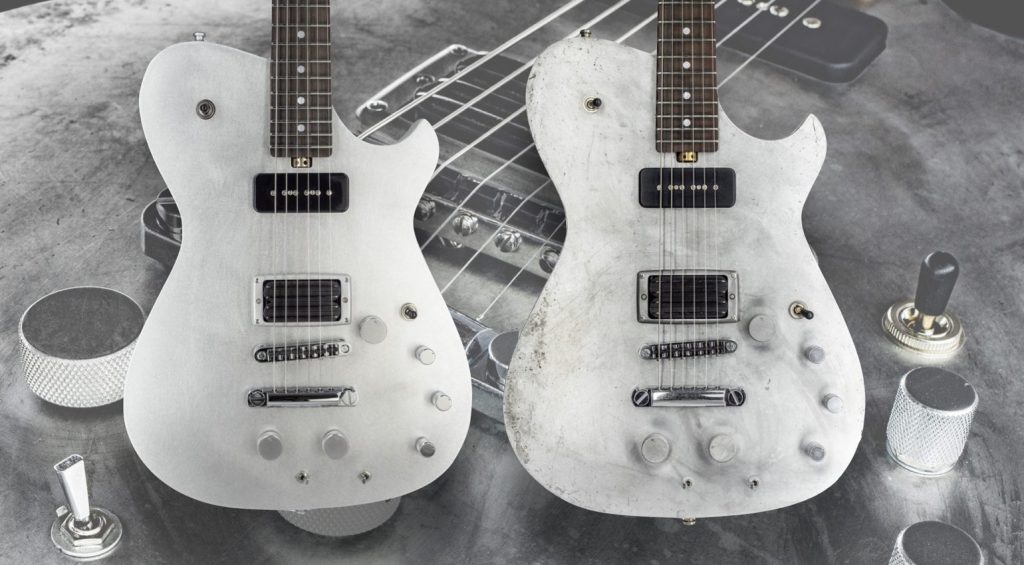
Manson Bomber
Bellamy’s Bomber guitar, named for both its industrial appearance and locking Floyd Rose tremolo, was prominently used on Muse’s Absolution and Black Holes and Revelations tours, and features a distinctive air-brushed chrome body covering embossed with rivets from a WWII-era Spitfire plane.
The Manson Bomber also features an Ibanez neck and Rio Grande Jazzbar and BKP Nailbomb pickups in the neck and bridge positions respectively, and includes both a MIDI strip controller sourced from an old Roland synth and a Digitech Whammy controller built into the rear cavity of the guitar, resulting in a highly unique instrument to match Muse’s sound.
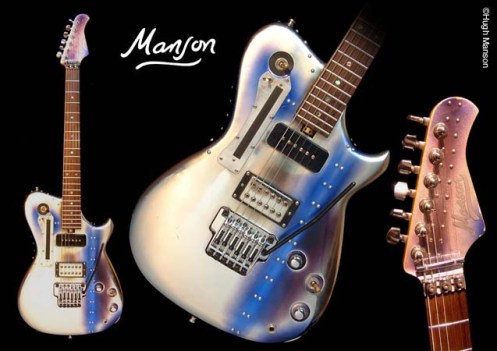
Manson Red Glitter
Sharing a similar body to his Delorean model, Bellamy’s Manson Red Glitter was debuted live in 2007, and features a unique electronics circuit consisting of a Fernandes Sustainer pickup to produce infinite feedback and an X-Y MIDI touchscreen to control a Korg KAOSS pad. While this instrument was later destroyed after years of use and abuse by Bellamy in 2010, it was replaced by a near identical model, which was later made commercially available as the Manson MB-1.
For those who can’t handle the hefty price tag of the Manson, Cort also offer an officially approved replica of the MB-1, the Cort MBC1 Matthew Bellamy Signature Guitar.
It’s worth noting that Bellamy has actually played about 30 different variations of his Manson guitar over the years, including 7 strings, double-necks, mirrored and LED-speckled models, and even the infamous Keytar, most of which share the same electronics as models detailed above. Here’s a few highlights…
Manson black 7-string

Manson ‘Keytar’
Fender Stratocaster
Bellamy has used various Stratocasters with Muse over the years, including an aluminium plated Aloha Stratocaster on the band’s 2001 Hullabaloo tour and a vintage ’60s model to record The 2nd Law cut ‘Animals’.
Gibson Les Paul DC Lite
For touring Showbiz, Bellamy’s main guitar was a slimline double-cut Gibson Les Paul, featuring a Roland MIDI pickup and a distinctive duct-tape job around the edges of the body. However, like most of his instruments, this one didn’t last on the road for very long, with Bellamy ramming it into a guitar cab in Dublin in 2000.
Amplifiers
Across the band’s long career, Bellamy has utilised dozens of different amplifiers in the studio to compensate for their immense sonic diversity, ranging from high-gain Randall heads to vintage Fender Vibrolux combos depending on the occasion. However, his main amps for the majority of recording and touring with Muse have been a vintage Vox AC-30 head, a MIDI-controlled Diezel VH4, and a mixture of assorted Marshall heads, including the DSL100 and 1959HW 100.
Since the start of The 2nd Law world tour in 2013, Bellamy has ceased using traditional guitar amplifiers live, now relying on the Kemper Profiling Amplifier and Fractal Audio Systems Axe-FX rack units to digitise his guitar signal.
On earlier tours, Bellamy also utilised a Fender Hot Rod Deville Combo in conjunction with Soldano speaker enclosures, before upgrading to a towering wall of Marshall 4×10 cabinets. Bellamy also prominently uses a Dickinson 2×12 Mk2 to manipulate the squealing feedback of his fuzz tone on songs such as ‘Supermassive Black Hole’.
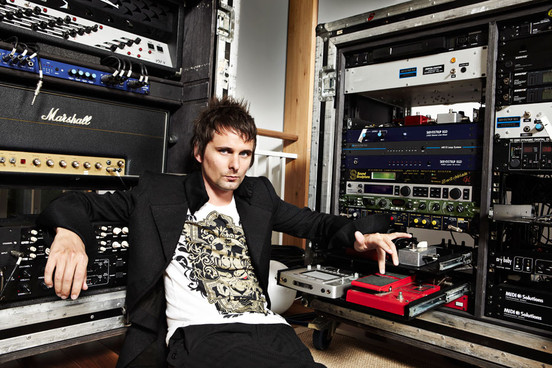
Effects
Thanks to the high-tech internal circuitry of his Manson guitars, the majority of Bellamy’s most used effects are able to be controlled directly through the guitar either via built-in effects or through MIDI capability, allowing Bellamy to have a relatively restrained pedalboard for earlier shows. Prior to Absolution, Bellamy’s pedalboard usually consisted of a Digitech Whammy, DOD Equalizer, Electro Harmonix Micro Synth, Line 6 DL4, Roland VG-8 V-Guitar system, Roland EV-5 Expression Pedal, and a Boss FV-300H volume pedal.
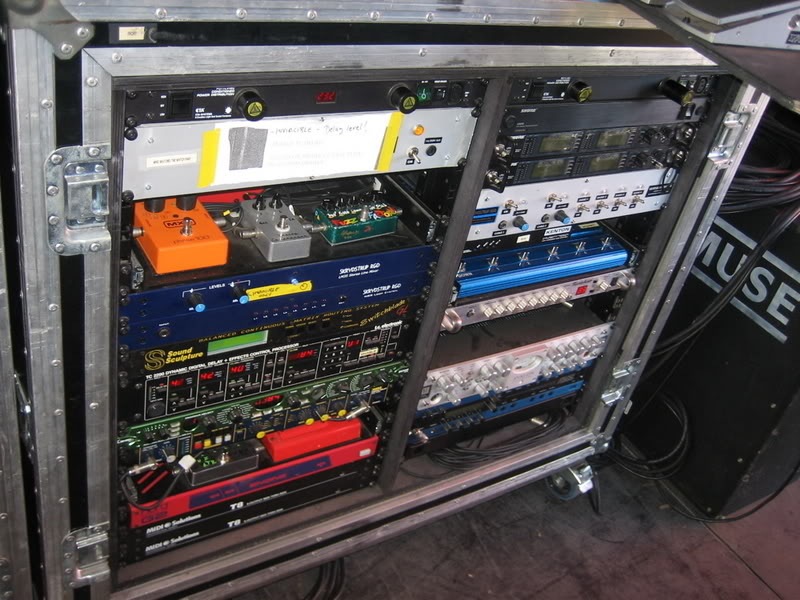
For Absolution, Bellamy began using a Rocktron All Access pedalboard controller, which was linked to a sophisticated bank of rack-mounted effects units. By the time Muse were touring The Resistance, he fully upgraded his onstage pedalboard to be controlled by a Liquid Foot Pro MIDI Controller along with three expression pedals to control volume, Whammy, and Wah-Wah and a reverb and tuning pedal. Around this time, Bellamy’s rack effects comprised of a Keeley Compressor, Boss a OC-2 Octave, a Digitech Whammy, a MXR M109 6 Band EQ, 2 x Z.Vex Fuzz Factorys, a Comet Ray Gun Phaser, a TC Electronic Stereo Chorus Flanger, a Digitech Reverb, a Skrydstrup MR8 Loop System, a TC Electronic G-Major 2, a Line 6 Echo Pro and a Korg SDD 3000, famously used by The Edge, as well as a Korg KAOSS pad to further manipulate his guitar signal via the touch pad on his guitar.
Nowadays, Bellamy’s effects are almost fully controlled electronically by the Fractal Axe-FX II, with most of his rack space being used for the various MIDI units and guitar switching systems.
Keys and Synths
To handle the symphonic piano driven tracks in Muse’s repertoire such as ‘United States of Eurasia’ and ‘Buttlerflies and Hurricanes’, Bellamy has a Kawai MP8II Professional Stage Piano which is built into the housing of a grand piano, with the original sustain and dampening pedals linked to the electronic keyboard. This allows for Muse’s sound tech to effectively amplify the keyboard via line outputs as opposed to actually miking up an acoustic grand piano, and gives Bellamy a range of keyboard tones in a dedicated enclosure.
While most of the synth parts in Muse songs are now played by their ‘fourth’ member, session musician Morgan Nicholls, Bellamy previously used a Roland Juno on an early live version of Origin of Symmetry cut ‘Bliss’.
Following in the vein of Radiohead’s Jonny Greenwood, Bellamy also owns an Ondes Martenot, an early electronic instrument which attempted to emulate the sound of a theremin by varying the frequency of oscillations within the vacuum tubes of the instrument. You can see Bellamy use the instrument to record the ambience at the start of ‘The Resistance’ in the above video.
For more Muse content, check out the band’s 2001 breakthrough being remixed for a re-release.

